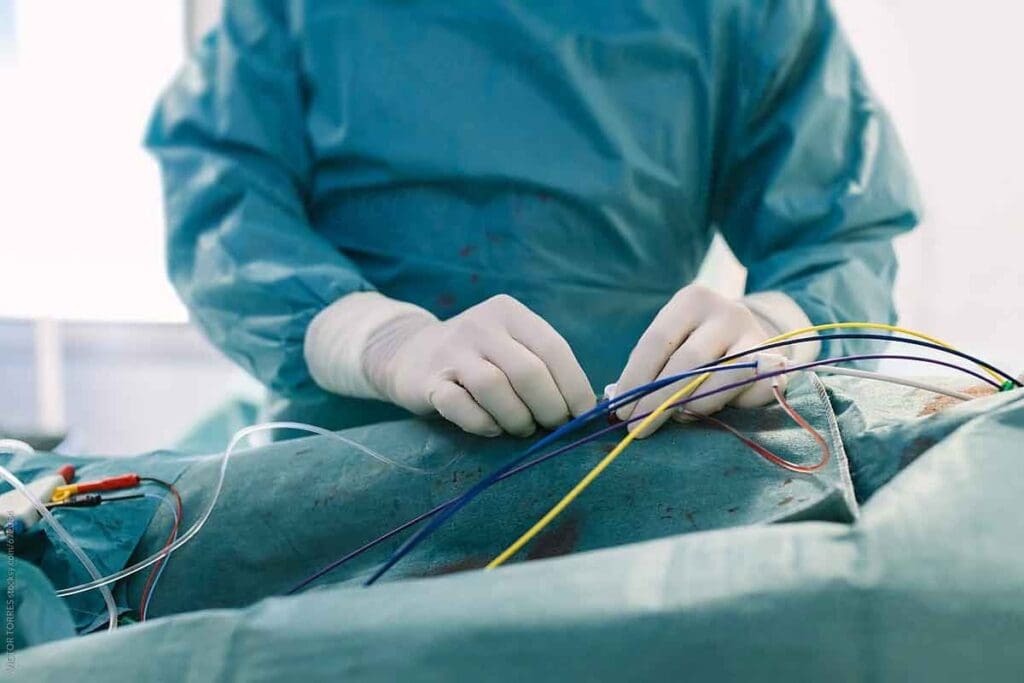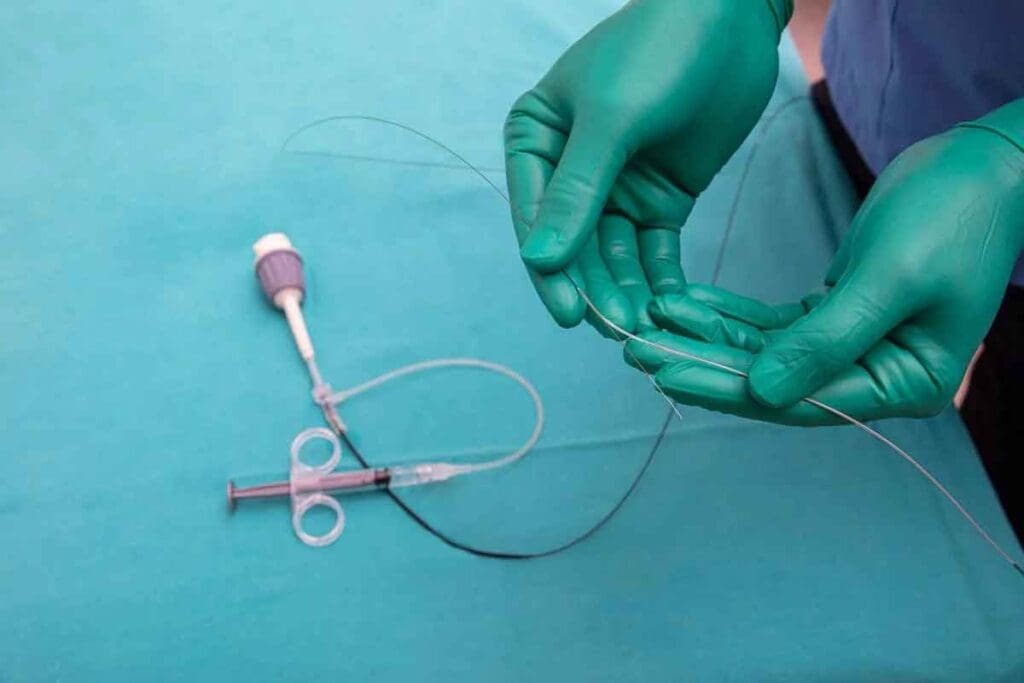Last Updated on November 26, 2025 by Bilal Hasdemir

Catheter ablation is a common treatment for heart rhythm problems, like atrial fibrillation. It affects millions globally. This minimally invasive procedure creates scars in the heart to stop irregular heartbeats. Find out how long does an ablation last and how results vary based on heart rhythm conditions.
The success of catheter ablation varies based on the patient and their heart condition. New technologies and care focused on the patient have boosted success ratesPatients need to know how long and how well catheter ablation works. This helps them decide if it’s the right choice for them.
Key Takeaways
- Catheter ablation is a minimally invasive procedure to treat arrhythmias.
- The success of the procedure depends on patient characteristics and underlying heart conditions.
- Advances in technology have improved cardiac ablation outcomes.
- Understanding the durability and success rates is key for patients.
- Catheter ablation can greatly improve life quality for those with atrial fibrillation.
Understanding Catheter Ablation for Cardiac Arrhythmias

Catheter ablation is a treatment for irregular heartbeats, or cardiac arrhythmias. It happens when the heart’s electrical signals get mixed up. This can make the heart beat too fast, too slow, or irregularly. Catheter ablation is a top choice for treating many arrhythmias, helping patients get a normal heart rhythm and a better quality of life.
The procedure uses a thin, flexible tube called a catheter. It’s inserted through a vein in the leg and guided to the heart. The catheter then sends energy to the heart area, causing the arrhythmia, creating lesions that stop the abnormal signals.
What is Catheter Ablation?
Catheter ablation is a minimally invasive method to fix heart rhythm problems. It aims to destroy the abnormal electrical pathways in the heart. This helps restore a normal heart rhythm, easing symptoms like palpitations, shortness of breath, and fatigue.
The procedure is done in an electrophysiology lab by a specialized cardiologist. Advanced imaging technologies guide the catheter to the exact spot in the heart where the arrhythmia starts.
Types of Arrhythmias Treated with Ablation
Catheter ablation treats many cardiac arrhythmias, including atrial fibrillation (AFib), atrial flutter, supraventricular tachycardia (SVT), and ventricular tachycardia (VT). Atrial fibrillation, the most common sustained arrhythmia, is characterized by rapid and irregular heartbeats. This treatment can greatly improve symptoms and quality of life for patients with these conditions.
The ablation success rate depends on the arrhythmia type and individual patient factors. For some arrhythmias, like SVT, success rates are often over 90%. For more complex conditions like atrial fibrillation, success rates vary. But new technology and techniques are making outcomes better.
The Catheter Ablation Procedure Explained

The catheter ablation procedure is a new way to treat heart rhythm problems. It uses thin wires to find and fix the heart’s electrical issues.
How the Procedure is Performed
An electrophysiologist puts thin, flexible wires into a blood vessel. They guide these wires to the heart using X-rays. Once there, they can see the heart’s electrical signals and find the problem.
Ablation is done by sending energy through the wire to destroy the bad area. The whole thing is done under local anesthesia, with sedation to help relax the patient. It usually takes 2 to 4 hours.
Technologies Used in Modern Ablation
Today’s ablation uses new tech to make it better and safer. 3D mapping makes a detailed heart map. This helps find and fix the heart’s rhythm problems exactly.
Contact force sensing lets the doctor know how much pressure to use. This makes the treatment more effective.
Duration and Hospital Stay
The procedure usually takes 2 to 4 hours. Most people go home the same day or after a night in the hospital.
After, patients are watched for a few hours for any issues. They get advice on caring for themselves and when to come back for more checks.
Patient Selection and Preparation
To get the most from catheter ablation, it’s key to pick the right patients. A detailed check is needed to see if the procedure fits the patient.
Ideal Candidates for Catheter Ablation
Catheter ablation is best for those with arrhythmias that meds or other treatments can’t fix. Ideal candidates have arrhythmias caused by a specific heart area that can be treated with ablation.
Doctors look at many things to decide if ablation is right. This includes the type and how bad the arrhythmia is, the patient’s health, and their medical history. For example, people with atrial fibrillation might get an ablation if other treatments didn’t work.
Pre-Procedure Testing and Evaluation
Before ablation, patients get tested to check their hearts and spot any risks. These tests might include:
- Electrocardiogram (ECG) to check heart rhythm
- Echocardiogram to look at heart structure and function
- Blood tests to find any hidden conditions
- Stress test to see how the heart works under stress
| Test | Purpose |
| Electrocardiogram (ECG) | Check heart rhythm and find arrhythmias |
| Echocardiogram | Look at the heart structure and function |
| Blood Tests | Find hidden conditions that might affect the procedure |
Medication Management Before Ablation
Managing meds is a big part of getting ready for catheter ablation. Patients often have to stop some meds before the procedure to lower risks. The meds to stop and for how long depend on the type of medication and the patient’s health.
For instance, anticoagulants might need to be stopped a few days before to cut down the bleeding risk. Patients need to follow their doctor’s advice on meds to make sure the procedure is safe and works well.
How Long Does an Ablation Last?
People often wonder how long catheter ablation lasts. The answer varies a lot. It depends on the type of arrhythmia and the patient’s health.
Average Duration of Ablation Benefits
Research shows that over half of patients stay free from arrhythmia 6 months after ablation. Even after more treatments, up to 85% of patients can stay arrhythmia-free. These numbers give a general idea, but results can differ.
Differences in Longevity by Arrhythmia Type
The type of arrhythmia affects how long ablation works. For example, ablation for supraventricular tachycardia (SVT) often works better than for atrial fibrillation. Knowing this helps set realistic hopes.
Factors Affecting Longevity of Results
Many things can change how long ablation lasts. These include the patient’s health, any heart disease, and the procedure’s techniques. Post-procedure care and follow-ups also play a role. Healthcare providers use this info to guide patients.
It’s important to remember that ablation doesn’t always prevent future arrhythmias. So, patients often need ongoing monitoring and more treatments. This is part of managing their condition long-term.
Success Rates of Catheter Ablation
Knowing the success rates of catheter ablation is key for those thinking about it. This procedure is a big help for many heart rhythm problems. It’s a good choice for those tired of taking medication for a long time.
First-Time Procedure Success Rates
The success of catheter ablation depends on the heart problem being treated. For atrial fibrillation, the first try works for 44 to 56 percent of people. But, after one or two more tries, it works for 66 to 67 percent.
A top cardiologist says, “The best results come when the procedure is matched to the patient’s needs.”
“The success rate of catheter ablation for atrial fibrillation can be as high as 70% in carefully selected patients.”
Success Rates for Specific Arrhythmias
Not all heart rhythm problems respond the same to catheter ablation. For example, supraventricular tachycardia (SVT) and atrial flutter often work better. SVT can be fixed over 90 percent of the time in some cases.
This shows how important it is to get the right treatment for each person.
Cardiac Catheter Ablation Success Rates Over Time
Looking at long-term success is important for both patients and doctors. The first results are good, but long-term success depends on many things. These include heart disease, age, and other health issues.
A study in a well-known medical journal found that about 50% of patients with atrial fibrillation remain successful for 5 years.
By knowing these success rates, patients can make better choices about their treatment.
Timeline of Recovery and Results
The journey to full recovery after catheter ablation has several stages. Knowing these stages helps manage expectations and ensures a smooth recovery.
Immediate Post-Procedure Period
After catheter ablation, patients are watched for a few hours. Most go home the same day or the next. It’s important to avoid heavy lifting for 48 hours to prevent bleeding.
Some may feel sore or bruised where the catheter was inserted. This usually goes away on its own.
Key aspects to focus on during the immediate post-procedure period include:
- Resting adequately
- Following the medication regimen as prescribed
- Monitoring for any signs of complications
6 Months After Heart Ablation
By six months, many patients have fully recovered. They can start exercising again. The heart rhythm should be stable, and the procedure’s success is clear.
It’s essential to follow up with your healthcare provider to check the procedure’s success and address any concerns or symptoms.
Long-Term Outcomes (1-10 Years)
Long-term results after catheter ablation vary. They depend on the type of arrhythmia, the patient’s health, and other factors. Studies show many patients stay free from arrhythmia for years.
Regular check-ups with a healthcare provider are key to monitoring long-term results and catching any issues early.
The success of catheter ablation can greatly improve life quality. Patients should know about the chance of arrhythmia coming back and the need for repeat procedures.
When Repeat Ablations Are Necessary
For some, catheter ablation might not be a one-time deal. Arrhythmia can come back, making repeat ablations necessary. It’s key to know when and why this happens to manage arrhythmia well.
Signs of Arrhythmia Recurrence
Arrhythmia can come back after ablation, showing up as symptoms like palpitations or shortness of breath. It’s important to watch for these signs to catch recurrence early. Sometimes, it comes back the same way; other times, differently.
Regular check-ups with a doctor are critical. They help keep an eye on the heart’s rhythm and spot any recurrence early. Tests like ECGs or Holter monitors can check the heart’s rhythm and find arrhythmia.
Timing of Repeat Procedures
When to repeat ablations depends on several things. These include the type of arrhythmia, how well the first procedure worked, and the patient’s health. Repeat procedures are usually needed when an arrhythmia comes back after a while.
A study in the Journal of Cardiovascular Electrophysiology found most recurrences happen in the first year. Early recurrence might mean a higher chance of needing another procedure.
Success Rates After Multiple Ablations
The success of repeat ablations can change based on several factors. These include the heart condition and the arrhythmia being treated. Studies show that while success rates might drop, many patients benefit from repeat ablations.
| Number of Ablations | Success Rate (%) | Study Findings |
| First Ablation | 70-80 | Initial success rates are generally high for most arrhythmias. |
| Second Ablation | 50-70 | Success rates decrease but remain significant for many patients. |
| Third or More Ablations | 30-50 | Success rates vary widely, often depending on the complexity of the arrhythmia. |
These findings show the need for personalized treatment plans. They also highlight the importance of ongoing evaluation to find the best approach for patients needing repeat ablations.
After Effects of Catheter Ablation
The effects of catheter ablation can vary. They can range from mild and short-term to serious complications. Knowing what to expect is key to making informed choices.
Common Short-Term Side Effects
Most people face some side effects after catheter ablation. These are usually mild and don’t last long. Common side effects include:
- Discomfort or pain at the catheter site
- Fatigue
- Mild swelling or bruising
These symptoms usually go away within a few days to a week. Effective pain management and proper care can help ease discomfort during recovery.
Long-Term Side Effects of Cardiac Ablation
Long-term side effects of catheter ablation are rare but can happen. Some possible long-term issues include:
- Persistent discomfort or pain
- Changes in heart rhythm (new or recurrent arrhythmias)
- Rarely, damage to the heart or major blood vessels
Regular follow-up with a healthcare provider is vital for tracking and managing long-term effects.
Managing Complications
While complications are rare, it’s important to have a plan for them. Strategies for managing complications include:
- Close monitoring of the patient’s condition post-procedure
- Adjustments to medication as needed
- In some cases, additional procedures may be required
Patients should watch for signs of complications, like increased heart rate, fever, or severe pain. Knowing when to seek medical help is important.
Conclusion
Catheter ablation is a key treatment for many heart rhythm problems. It helps reduce symptoms and improves life quality. The success of the procedure depends on the type of arrhythmia and the patient’s health.
Understanding catheter ablation is important for both patients and doctors. This article has covered the basics of the procedure and its benefits. It shows that catheter ablation can be a lasting solution for many arrhythmia patients.
In short, catheter ablation is a trusted treatment for heart rhythm issues. Its success can vary based on several factors. As medical technology gets better, catheter ablation will likely become even more effective, giving hope to those with arrhythmias.
FAQ
What is catheter ablation, and how does it work?
Catheter ablation is a procedure to treat heart rhythm problems. It uses a thin tube to find and destroy the bad electrical paths in the heart. This helps fix irregular heartbeats.
How long does a catheter ablation procedure typically last?
The time needed for a catheter ablation procedure varies. It usually takes between 2 to 6 hours. This depends on how complex the heart rhythm problem is.
How long do the benefits of catheter ablation last?
The benefits of catheter ablation can last differently for everyone. On average, they can last from a few years to a lifetime. It depends on the type of heart rhythm problem and the individual.
What are the success rates of catheter ablation for atrial fibrillation?
Success rates for catheter ablation in treating atrial fibrillation vary. Studies show it works well for about 50-70% of patients after one procedure. This means their heart rhythm can return to normal.
How long does it take to recover from a catheter ablation procedure?
Recovery from a catheter ablation procedure is usually quick. Most people can go back to normal activities within a few days to a week after the procedure.
What are the common short-term side effects of catheter ablation?
Short-term side effects of catheter ablation include bruising, bleeding, or discomfort at the site where the catheter was inserted. Fatigue, chest pain, or palpitations are also common.
Can arrhythmia recur after catheter ablation?
Yes, arrhythmia can come back after catheter ablation. How likely it is to happen depends on the type of arrhythmia and individual factors.
When are repeat catheter ablation procedures necessary?
Repeat procedures are needed when an arrhythmia comes back after a successful first procedure. The decision to have another procedure depends on the patient’s situation and how severe their symptoms are.
What are the long-term side effects of cardiac ablation?
Rare but possible long-term side effects of cardiac ablation include damage to the heart or surrounding tissues. There’s also a chance for new arrhythmias to develop.
How do I manage complications after catheter ablation?
Managing complications after catheter ablation involves following up closely with a healthcare provider. It’s important to follow post-procedure instructions and report any concerning symptoms or side effects right away.
References
Brugada, J., Katritsis, D. G., Arbelo, E., Arribas, F., Bax, J. J., Blomström-Lundqvist, C., Calkins, H., Corrado, D., Deftereos, S. G., Diller, G. P., Gomez-Doblas, J. J., Gorenek, B., Grace, A., Ho, S. Y., Kaski, J. C., Kuck, K. H., Lambiase, P. D., Skanes, A. C., Pava, L. F., … ESC Scientific Document Group. (2020). 2019 ESC Guidelines for the management of patients with supraventricular tachycardia. European Heart Journal, 41(5), 655–720. https://www.ncbi.nlm.nih.gov/pmc/articles/PMC7022822/






